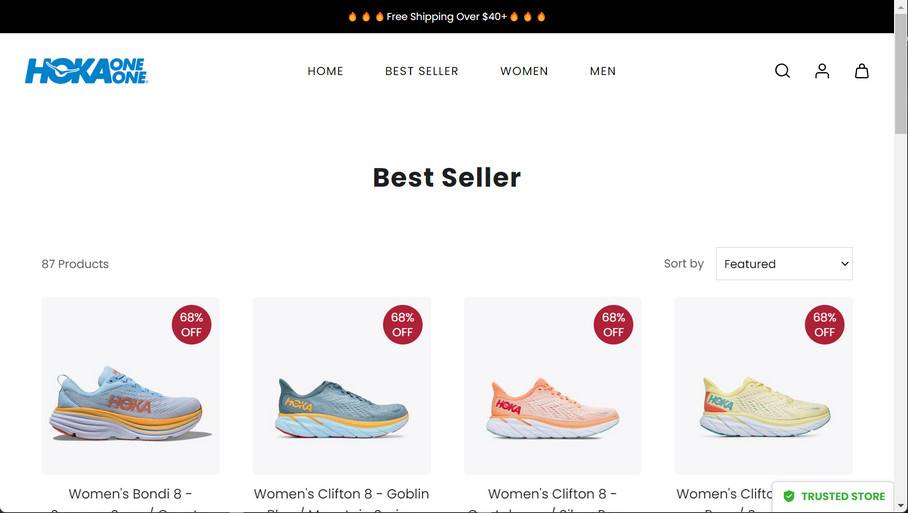Online scammers are duping shoe shoppers with fake websites offering discounted HOKA sneakers. These fraudulent sites lure victims in with prices like $19.99 for shoes that normally cost $140. Using convincing copies of legitimate retailers, they trick users into handing over personal and payment information. If you’ve seen unbelievable HOKA deals online, read this article to uncover the sneaky tricks behind this scam and learn how to avoid becoming a victim.

This Article Contains:
What is the HOKA Sneakers $19.9 Scam?
The HOKA Sneakers $19.9 Scam is an online fraud targeting shoppers with fake websites offering HOKA sneakers at an unbelievably low price. These deceptive sites mimic authentic retailers like DICK’S Sporting Goods and Road Runner Sports, using copied logos and images to appear genuine.
Leveraging social media ads and sketchy pop-up ads, they attract victims with tempting “50-90% off” discounts and redirect traffic to hide their tracks.
The end goal of this scam is to harvest the personal and financial data of unwitting shoppers who fall for the fake discounts. After handing over their information, victims are left with either cheap knockoff shoes that are nothing like the real HOKAs advertised, or more commonly, they receive nothing at all. The fraudsters take the stolen data and disappear, leaving the victims frustrated and vulnerable to identity theft.
How Does the $19.9 HOKA Sneakers Scam Work?
This clever scam works in multiple stages:
Baiting Shoppers with Tempting Ads
The first step is baiting unsuspecting shoppers with social media ads, sketchy pop-ups, or fake “coupon” sites offering HOKA shoes for over 90% off. For example, a popular HOKA style that normally retails for $140 is advertised for only $19.99.
The ads use eye-catching images of genuine HOKA shoes and legitimate branding. This creates the illusion that the deals are from an authorized retailer.
Redirecting to Fraudulent Sites
If shoppers click on these too-good-to-be-true ads, they get redirected to fake ecommerce sites that mimic legitimate HOKA retailers. The sites look convincingly real, using stolen branding, logos, and product photos of the actual company.
Some of these scam sites even use sneaky tactics like JavaScript redirects to hide their tracks. This makes it harder for victims to trace back the original ad or report the site.
Collecting Personal and Payment Information
On the fake ecommerce sites, shoppers are prompted to provide their personal information like name, address, and phone number, as well as payment details like credit card information.
Victims entering this data believe they are making a purchase from an official retailer. But in reality, they are handing over their personal information directly to scammers.
Sending Fake Products or Stolen Data
After collecting victims’ information and payment, the scammers either send a cheap counterfeit product or nothing at all.
In some cases, they use the stolen credit card details to make additional fraudulent purchases before the victim can notice and cancel the card. Either way, the scammers disappear after successfully pulling off their con.
Warning Signs of the HOKA Sneakers Scam:
There are a few red flags that can help identify these fraudulent sites:
- Prices that are too good to be true, like 90% off retail value.
- Typos, grammatical errors, and other telltale signs of a hastily created site.
- Generic contact information like a Gmail address instead of official support channels.
- No physical address listed on the site.
- Customer service contacts that don’t actually respond or answer questions.
- Reviews section with generic names and overly positive feedback.
- Lack of security badges like Verified by Visa or Mastercard SecureCode.
- Requests for direct bank transfers instead of regular online checkout.
- URLs that mimic but don’t exactly match official sites (e.g. hoka-online-store.com instead of hoka.com)
How to Avoid Falling Victim to the $19.9 HOKA Scam:
While these fake deals might look incredibly tempting, there are a few precautions shoppers should take to avoid getting scammed:
- Stick to official retailer sites – The best way to ensure a site is legitimate is to only shop directly from the official HOKA site or authorized retailers like DICK’S Sporting Goods and Road Runner Sports. Avoid random sites advertising massive discounts.
- Beware of social media ads – Approach tempting social media ads offering big discounts with skepticism. Double check that the site it redirects to matches official URLs.
- Research unfamiliar sites – If you come across an unknown retailer site with cheap HOKAs, look for reviews and complaints online mentioning “scam” or “fake”. Dig into the site’s history using WHOIS domain lookup.
- Avoid direct bank transfers – Never make direct bank transfers to unknown sites. Stick to secure payment processors like PayPal which offer buyer protection.
- Use credit cards – Paying with a credit card gives you the ability to dispute fraudulent charges. Debit cards and direct bank transfers don’t offer this protection.
- Verify security certificates – Check that the site has a padlock icon and https URL, indicating SSL encryption is in place to protect your data.
- Trust your gut – If you get a bad feeling about a site or deal that seems unrealistic, listen to your gut feeling and avoid purchasing.
What to Do if You Already Fell for the HOKA Sneakers Scam:
If you unfortunately already provided your information and made a purchase from one of these fraudulent sites, take the following steps right away:
- Contact your bank and credit card company – Alert them to the fraudulent charges and request that the payments get reversed. Cancel any cards that may have been compromised.
- Report the site – Use WHOIS data to find the domain registrar and host, and report the scam site to get it taken down. Also report it to the FTC.
- Place fraud alerts – Consider putting a fraud alert on your credit report to protect your identity and prevent criminals from opening new accounts.
- Reset account passwords – If you used the same password on multiple sites, change it everywhere to prevent additional security breaches.
- Watch for suspicious activity – Keep monitoring your financial accounts and credit reports over the next few months for any fraudulent activity.
- Learn from it – Going forward, be more vigilant about scam ads and deals that seem too good to be true. Stick to trusted retailers to avoid repeat victimization.
FAQ About the HOKA Sneakers Scam
Are the shoes actually HOKA brand?
In most cases, the shoes sold through these scam sites are cheap counterfeit imitations being passed off as genuine HOKA. They rely on copied branding and images to deceive buyers.
How are they advertising these deals?
The scam ads are showing up on social media sites like Facebook and Instagram, sometimes disguising themselves as sponsored posts. They also use deceptive pop-up ads that redirect to the fake sites.
Can I get my money back if I paid with a credit card?
Yes, one advantage of paying by credit card is the ability to dispute the charges as fraudulent and get reimbursed by your card issuer. But you need to act quickly to report it.
Is this only happening on one particular website?
No, the scam uses multiple similarly named sites with slight URL variations, all advertising the same fake deals. This makes it harder to track down and shut down.
Are these sites actually based in the United States?
In most cases no, the people behind them conceal their location but appear to be operating overseas, beyond the reach of US consumer protection laws.
The Bottom Line
The HOKA Sneakers $19.9 scam is an increasingly common online fraud that tries to bait unsuspecting shoppers with unbelievable discounts. But behind the tempting offers are fake sites out to steal your money and personal data. Protect yourself by being skeptical of social media ads, using secure payment methods, and only shopping on authorized retailer websites. If you do get tricked, act quickly to have charges reversed and accounts shut down. With vigilance, you can avoid becoming another victim of this insidious scam.












